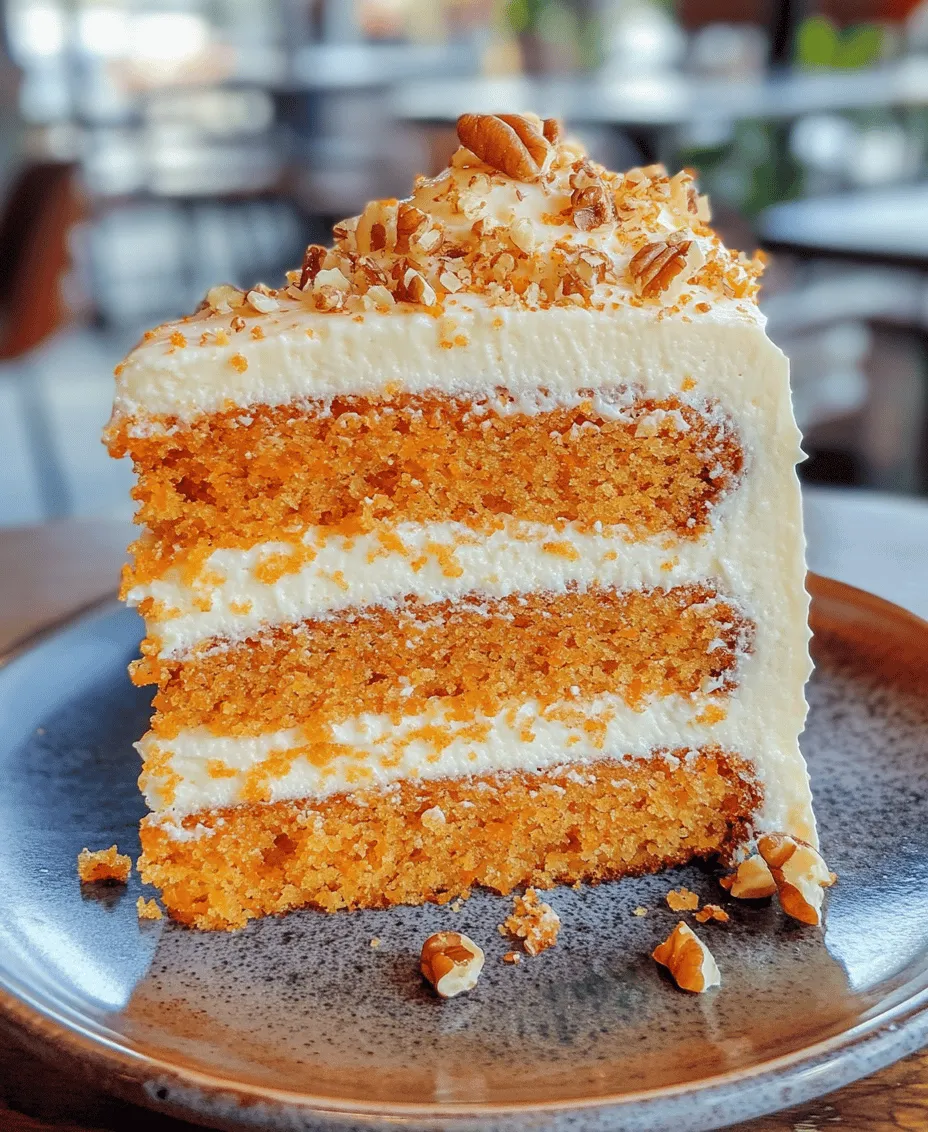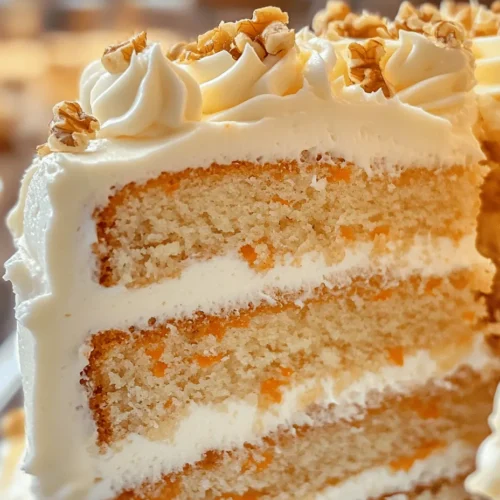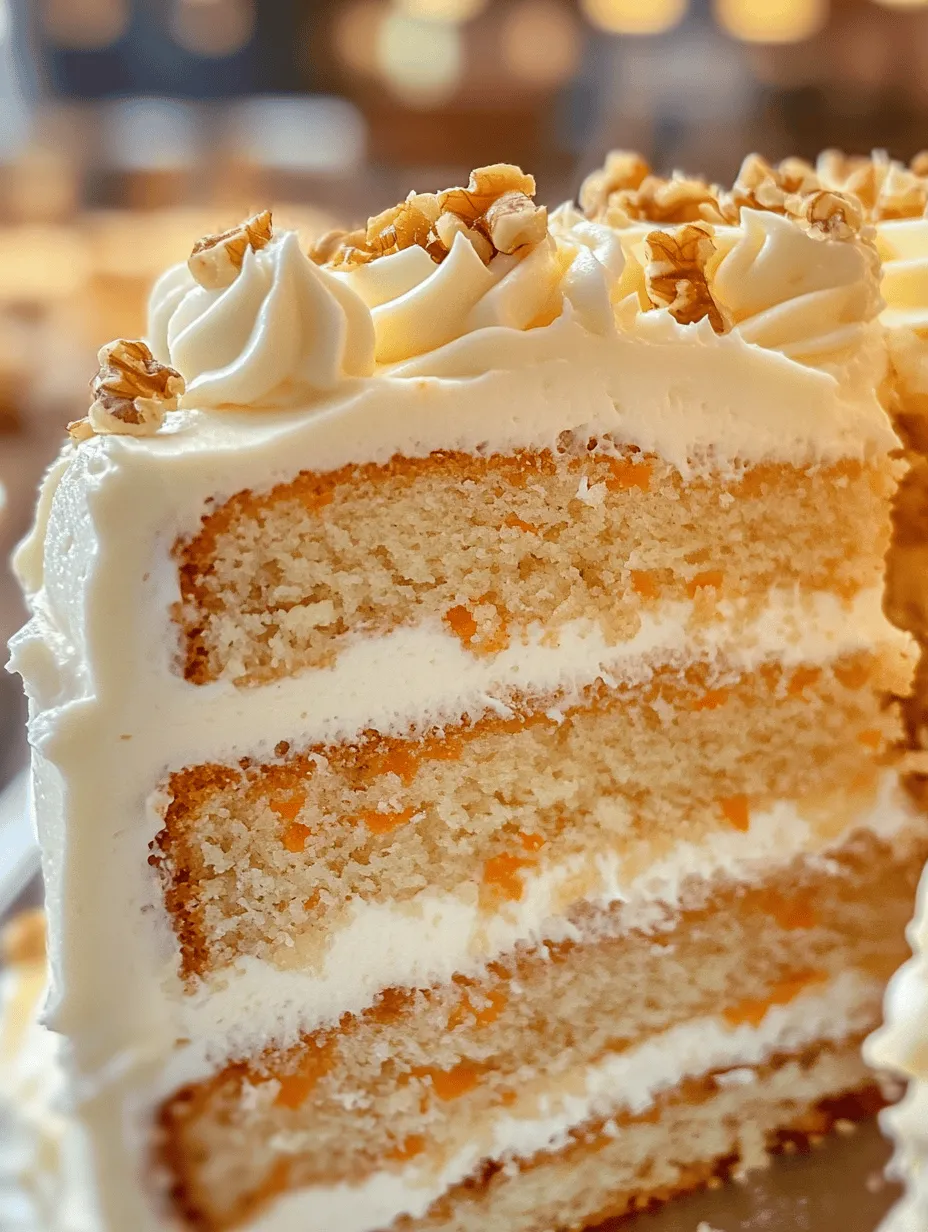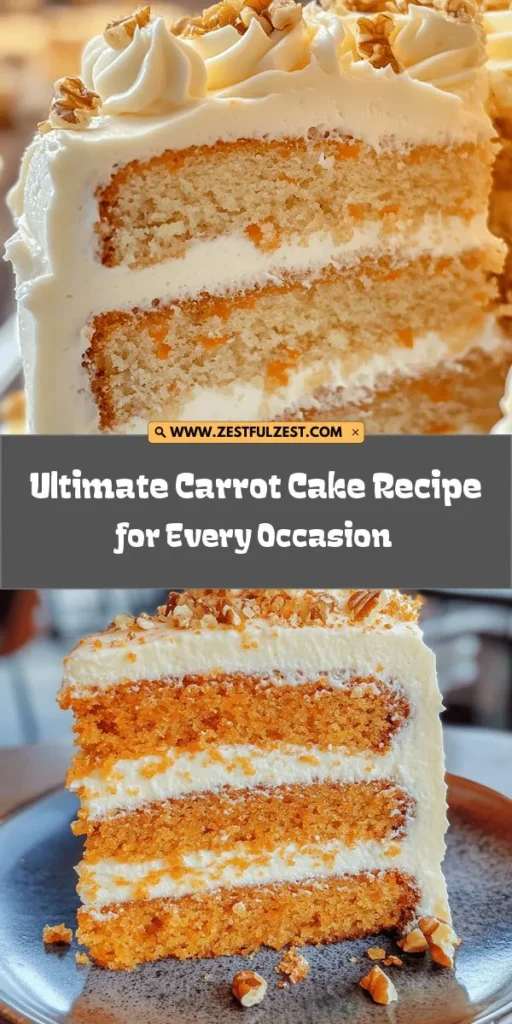Introduction
Carrot cake has secured its place among the most beloved desserts in the world, captivating the taste buds of many with its unique combination of flavors and textures. This moist, spiced cake, often adorned with a rich cream cheese frosting, offers a delicious balance of sweetness and warmth, making it a favorite for both casual gatherings and formal celebrations. Whether it’s a birthday party, holiday feast, or simply a cozy afternoon treat, carrot cake is a versatile dessert that never fails to impress.
What makes carrot cake truly special is the delightful fusion of ingredients that come together to create a symphony of flavors. The natural sweetness of finely grated carrots melds beautifully with warm spices, while the addition of crushed pineapple and nuts adds layers of flavor and texture. Each bite delivers a moist, tender crumb, complemented by the rich creaminess of frosting that enhances the overall experience. It’s no wonder that carrot cake is often associated with comfort and joy, making it a go-to choice for many occasions.
In this article, we will explore the ins and outs of creating the perfect carrot cake, providing you with a comprehensive guide that covers everything from its rich history to detailed instructions for baking. Whether you are a seasoned baker or a novice in the kitchen, this recipe will empower you to create a delicious carrot cake that will leave everyone asking for seconds.
Understanding Carrot Cake
Carrot cake has a fascinating history that dates back centuries. It is believed that the concept of using carrots in cakes originated during the Middle Ages when sugar and sweeteners were scarce. Resourceful bakers turned to carrots, which are naturally sweet, as an alternative to create desserts. The modern iteration of carrot cake that we know and love today began to emerge in the 20th century, gaining popularity in the United States during the 1960s and 1970s. Its rise coincided with the health food movement, as many began to embrace the idea of incorporating vegetables into sweet treats, making carrot cake a trendy dessert option.
Beyond its intriguing history, carrot cake boasts several health benefits, largely due to its star ingredient: the carrot. Carrots are packed with essential nutrients, including vitamins A, C, and K, as well as fiber and antioxidants. These healthful properties not only contribute to the cake’s moistness but also provide a guilt-free indulgence when enjoyed in moderation. The addition of crushed pineapple further enhances the nutritional profile of the cake, introducing additional vitamins and moisture that elevate its texture.
Throughout the world, variations of carrot cake can be found, each reflecting the unique culinary traditions of different cultures. From the rich, dense cakes of the Caribbean to the lighter, spongy versions popular in parts of Europe, carrot cake has adapted and evolved, showcasing its versatility. Some variations even incorporate tropical fruits, coconut, or different nuts, allowing for a delightful twist on the classic recipe.
Ingredients Breakdown
To create a truly exceptional carrot cake, it’s essential to understand the role of each ingredient in the recipe. Below is a detailed description of the key ingredients that come together to make this delightful dessert:
1. All-purpose flour: Serving as the foundation of the cake, all-purpose flour provides the necessary structure to hold the cake together. Its protein content creates the framework for the cake, allowing it to rise and maintain its shape.
2. Granulated sugar: The primary source of sweetness in the cake, granulated sugar not only enhances the flavor but also contributes to the cake’s moisture. The sugar interacts with other ingredients during baking to create a tender crumb.
3. Baking powder and baking soda: These leavening agents are crucial for achieving fluffiness in the cake. Baking powder helps the cake rise by releasing carbon dioxide during baking, while baking soda enhances the cake’s browning and flavor.
4. Spices (cinnamon, nutmeg): Spices play a vital role in flavor enhancement, infusing the cake with warm, aromatic qualities. Cinnamon and nutmeg are traditional spices used in carrot cake, adding depth and complexity to the overall flavor profile.
5. Salt: A small but significant ingredient, salt balances the sweetness of the sugar and enhances the overall flavor of the cake. It also helps to bring out the natural flavors of the other ingredients.
6. Vegetable oil: Unlike butter, vegetable oil contributes to the moisture and tenderness of the cake. It creates a moist texture while keeping the cake light and fluffy.
7. Eggs: Eggs serve multiple purposes in the recipe. They act as a binding agent, holding the ingredients together while adding richness and moisture to the cake.
8. Finely grated carrots: The star ingredient of this recipe, finely grated carrots provide natural sweetness, moisture, and texture. Their incorporation not only adds flavor but also gives the cake its signature orange hue.
9. Crushed pineapple: Introducing a tropical twist, crushed pineapple adds extra moisture and natural sweetness to the cake. Its acidity helps to balance the flavors and contributes to a tender crumb.
10. Chopped walnuts: While optional, chopped walnuts provide a delightful crunch and nutty flavor that complements the sweetness of the cake. They also add an additional layer of texture, making each bite more enjoyable.
11. Vanilla extract: A staple in many baked goods, vanilla extract enhances the overall flavor profile of the cake, bringing all the ingredients together harmoniously.
Step-by-Step Instructions for Carrot Cake
Before diving into the baking process, it’s essential to prepare your kitchen and gather all the necessary tools and equipment. Here’s a list of what you will need to ensure a smooth baking experience:
– Mixing bowls: A set of mixing bowls in various sizes will help you combine dry and wet ingredients efficiently.
– Measuring cups and spoons: Accurate measurements are crucial for baking, so ensure you have a reliable set of measuring cups and spoons on hand.
– Grater: A box grater or food processor will make quick work of finely grating the carrots.
– Whisk: A whisk is essential for mixing dry ingredients and ensuring a smooth batter.
– Rubber spatula: A rubber spatula will help you fold in ingredients gently and scrape down the sides of mixing bowls.
– Cake pans: Prepare two round (9-inch) cake pans for baking the cake layers. Ensure they are greased and lined with parchment paper for easy removal.
– Oven thermometer: To ensure accurate baking temperatures, an oven thermometer can help monitor your oven’s heat levels.
With your tools ready, you’re well-prepared to embark on the journey of creating a delightful carrot cake that will surely impress all who taste it. In the next section, we will dive into the detailed step-by-step instructions for assembling and baking your carrot cake, ensuring that it turns out perfectly every time. Stay tuned to learn how to mix, bake, and ultimately enjoy this timeless dessert!

Detailed Steps for Mixing the Batter
Creating a luscious carrot cake requires careful attention to detail, especially in the mixing process. Here’s how to achieve the perfect batter:
Preparing the Cake Pans
Begin by preparing your cake pans. Grease two 9-inch round cake pans with butter or cooking spray, ensuring all surfaces are covered to prevent sticking. For added security, you can place a circle of parchment paper at the bottom of each pan. This step ensures that your cakes will release easily once baked, allowing you to achieve that perfect, clean edge.
Mixing Dry Ingredients Separately from Wet Ingredients
In a large mixing bowl, sift together the dry ingredients: flour, baking powder, baking soda, cinnamon, nutmeg, and salt. Sifting not only combines these ingredients evenly but also aerates the flour, which is crucial for a light and fluffy cake texture. In a separate bowl, whisk together the wet ingredients: eggs, granulated sugar, brown sugar, vegetable oil, and vanilla extract until they are well combined and the mixture is smooth.
Mixing the dry and wet ingredients separately prevents clumping and allows for better incorporation of each component into the final batter.
Importance of Not Overmixing the Batter
Once you combine the dry ingredients into the wet mixture, stir gently with a spatula or wooden spoon. It’s important to mix just until the flour is incorporated, as overmixing can lead to a tough cake. You want to maintain that tender crumb that carrot cake is known for, so be cautious and stop mixing once you see no dry flour.
Incorporating the Special Ingredients (Carrots, Pineapple, Nuts)
Now comes the fun part: adding the special ingredients that make this carrot cake exceptional. Fold in the grated carrots, crushed pineapple, and chopped nuts (such as walnuts or pecans) gently into the batter. These ingredients add moisture, flavor, and texture, creating a deliciously rich cake. Make sure the carrots are finely grated to ensure even distribution throughout the batter and optimal baking.
Baking Tips: How to Know When the Cake is Perfectly Done
Preheat your oven to 350°F (175°C). Divide the batter evenly between the prepared cake pans and smooth the tops with a spatula. Bake for 25 to 30 minutes, but keep an eye on them. To test for doneness, insert a toothpick into the center of the cakes. If it comes out clean or with a few moist crumbs, your cakes are ready. If there’s wet batter on the toothpick, give them another few minutes but check frequently to avoid overbaking.
Cooling the Cakes: Importance of Allowing Them to Cool Properly
Once the cakes are baked, remove them from the oven and allow them to cool in the pans for about 10 minutes. Then, carefully turn them out onto a wire rack to cool completely. This step is crucial; cooling the cakes properly helps them maintain their structure and prevents them from becoming soggy.
Crafting the Perfect Cream Cheese Frosting
Cream cheese frosting is the traditional accompaniment for carrot cake—and for good reason. Its tangy flavor beautifully balances the sweetness of the cake while adding a creamy richness.
Step-by-Step Guide to Making the Frosting
1. Ingredients: Gather 8 ounces of softened cream cheese, 1/2 cup unsalted butter (softened), 4 cups powdered sugar, and 1 teaspoon vanilla extract.
2. Combine Softened Ingredients: In a large mixing bowl, beat the softened cream cheese and butter together using an electric mixer on medium speed until smooth and creamy. Softened ingredients are essential for achieving a velvety texture that spreads easily.
3. Add Sugar and Flavoring: Gradually add the powdered sugar, mixing on low speed to avoid a sugar cloud. Once incorporated, add the vanilla extract. Beat on medium-high until the frosting is smooth and fluffy.
4. Adjusting Consistency: If your frosting is too thick, add a splash of milk to reach your desired consistency for easy spreading. Conversely, if it’s too thin, add a little more powdered sugar until you get the right texture.
Tips for Frosting the Cake Beautifully
To frost your cake beautifully, first ensure it is completely cool. Level the tops of the cakes with a serrated knife if they have domed during baking, so they stack evenly. Place one layer on a serving plate and spread a generous amount of frosting on top. Carefully place the second layer on top and continue frosting the top and sides of the cake. For a polished look, use an offset spatula to smooth the frosting.
Consider using a piping bag fitted with a decorative tip for added flair on the top or edges of the cake.
Decorating Your Carrot Cake
Decorating your carrot cake can elevate its presentation, making it perfect for special occasions.
Creative Ideas for Decorating the Cake
– Using Walnuts as a Garnish: Toasted walnuts can be sprinkled on top of the frosting or pressed gently into the sides for a rustic look. They add a delightful crunch and complement the flavor of the cake.
– Other Topping Suggestions: Consider adding shredded coconut for texture, or dried fruits like raisins or cranberries for a pop of color. Edible flowers can also be a beautiful touch.
Presentation Tips for Serving the Cake at Gatherings or Special Occasions
To serve your cake, consider placing it on a decorative cake stand. This not only enhances the overall presentation but makes it easier for guests to serve themselves. You can also add a few sprigs of mint or edible flowers on the plate for a touch of elegance.
Serving Suggestions and Pairings
Carrot cake is versatile and perfect for various occasions. Here are a few ideal scenarios for serving:
Ideal Occasions for Serving Carrot Cake
– Birthdays: A classic choice for birthday celebrations, carrot cake is loved by many for its unique flavor.
– Holidays: Serve it during Easter or Thanksgiving as a delightful alternative to traditional desserts.
– Casual Get-Togethers: Its comforting flavors make it a great choice for family gatherings or coffee afternoons with friends.
Suggested Beverages That Complement the Flavors of Carrot Cake
Pair your carrot cake with a warm cup of coffee or spiced chai tea to enhance the flavors. If you prefer something sweeter, try a dessert wine or a sweet iced tea. These beverages will complement the cake’s rich flavors and provide a refreshing balance.
Conclusion
Making and sharing homemade carrot cake is a rewarding experience that brings joy to both the baker and the guests. The process from mixing the batter to frosting the cake allows you to create a beloved dessert from scratch, filled with wholesome ingredients and delicious flavors.
Whether you’re celebrating a special occasion or simply enjoying a slice with your afternoon tea, this carrot cake recipe is sure to impress. So, roll up your sleeves, gather your ingredients, and embark on this delightful baking adventure. Enjoy the process, and savor the satisfaction of creating something truly special!



